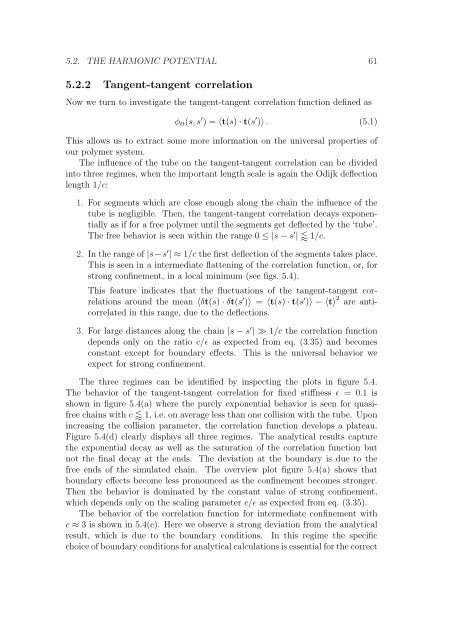Polymers in Confined Geometry.pdf
Polymers in Confined Geometry.pdf
Polymers in Confined Geometry.pdf
You also want an ePaper? Increase the reach of your titles
YUMPU automatically turns print PDFs into web optimized ePapers that Google loves.
5.2. THE HARMONIC POTENTIAL 61<br />
5.2.2 Tangent-tangent correlation<br />
Now we turn to <strong>in</strong>vestigate the tangent-tangent correlation function def<strong>in</strong>ed as<br />
φtt(s, s ′ ) = 〈t(s) · t(s ′ )〉 . (5.1)<br />
This allows us to extract some more <strong>in</strong>formation on the universal properties of<br />
our polymer system.<br />
The <strong>in</strong>fluence of the tube on the tangent-tangent correlation can be divided<br />
<strong>in</strong>to three regimes, when the important length scale is aga<strong>in</strong> the Odijk deflection<br />
length 1/c:<br />
1. For segments which are close enough along the cha<strong>in</strong> the <strong>in</strong>fluence of the<br />
tube is negligible. Then, the tangent-tangent correlation decays exponentially<br />
as if for a free polymer until the segments get deflected by the ‘tube’.<br />
The free behavior is seen with<strong>in</strong> the range 0 ≤ |s − s ′ | 1/c.<br />
2. In the range of |s−s ′ | ≈ 1/c the first deflection of the segments takes place.<br />
This is seen <strong>in</strong> a <strong>in</strong>termediate flatten<strong>in</strong>g of the correlation function, or, for<br />
strong conf<strong>in</strong>ement, <strong>in</strong> a local m<strong>in</strong>imum (see figs. 5.4).<br />
This feature <strong>in</strong>dicates that the fluctuations of the tangent-tangent correlations<br />
around the mean 〈δt(s) · δt(s ′ )〉 = 〈t(s) · t(s ′ )〉 − 〈t〉 2 are anticorrelated<br />
<strong>in</strong> this range, due to the deflections.<br />
3. For large distances along the cha<strong>in</strong> |s − s ′ | ≫ 1/c the correlation function<br />
depends only on the ratio c/ɛ as expected from eq. (3.35) and becomes<br />
constant except for boundary effects. This is the universal behavior we<br />
expect for strong conf<strong>in</strong>ement.<br />
The three regimes can be identified by <strong>in</strong>spect<strong>in</strong>g the plots <strong>in</strong> figure 5.4.<br />
The behavior of the tangent-tangent correlation for fixed stiffness ɛ = 0.1 is<br />
shown <strong>in</strong> figure 5.4(a) where the purely exponential behavior is seen for quasifree<br />
cha<strong>in</strong>s with c 1, i.e. on average less than one collision with the tube. Upon<br />
<strong>in</strong>creas<strong>in</strong>g the collision parameter, the correlation function develops a plateau.<br />
Figure 5.4(d) clearly displays all three regimes. The analytical results capture<br />
the exponential decay as well as the saturation of the correlation function but<br />
not the f<strong>in</strong>al decay at the ends. The deviation at the boundary is due to the<br />
free ends of the simulated cha<strong>in</strong>. The overview plot figure 5.4(a) shows that<br />
boundary effects become less pronounced as the conf<strong>in</strong>ement becomes stronger.<br />
Then the behavior is dom<strong>in</strong>ated by the constant value of strong conf<strong>in</strong>ement,<br />
which depends only on the scal<strong>in</strong>g parameter c/ɛ as expected from eq. (3.35).<br />
The behavior of the correlation function for <strong>in</strong>termediate conf<strong>in</strong>ement with<br />
c ≈ 3 is shown <strong>in</strong> 5.4(c). Here we observe a strong deviation from the analytical<br />
result, which is due to the boundary conditions. In this regime the specific<br />
choice of boundary conditions for analytical calculations is essential for the correct













